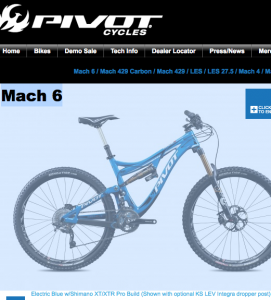The Sea Otter Classic coming up in April will host the broadest display of 650b/27.5 “enduro” bikes yet. And they’ll all be there for demo’ing by you and me.
It’s been a couple of years since the 27.5 platform emerged for mountain biking. But this year, the 2014 season, will be the first where every major mountain bike maker is offering dedicated, full-on, designed-for 27.5 bikes.
The buzz factor is in screech mode. Everywhere you look, you see 27.5 looking back at you. The cover of Mountain Bike Action. Showcased by IMB, an international digital app. And in the Web’s most exhaustive test report ever, MTBR.com’s “Enduro Compare-O” mega blowout.
You see 27.5s in store windows and showcase displays. They headline Demo Days. They’re top-tiered on bike maker Web sites.
They’re everywhere, they’re everywhere! Except one place…
The trails.
We ride all over the heartland of 27.5 country, the San Francisco Bay Area. We ride high and low and in between. And we keep our eyes peeled for hot new bikes.
And what we see are still mostly 26-ers. A small share of 29ers. And, once in awhile, a 27.5.
They’re rare. We saw a Pivot Mach 6 on Braille Trail in Soquel Demo a couple of months back. We ran across a Santa Cruz Bronson in front of Kelly’s Bakery in Santa Cruz a few weeks ago. An Intense Carbine 275 at Nisene Marks.
But that’s pretty much it. If these bikes are selling, if they’re having an impact, we’re missing it. (Caveat: 27.5s are hard to distinguish from 26ers at speed and at distance; we certainly may have missed some.)
Writing in BIKE magazine, Vernon Felton observed that the 27.5 platform hasn’t really earned its verts. It’s gotten blind adoption without proving itself on the trails.
Everybody says 27.5 will be their next bike, Felton noted. And he’s right. We’ve heard the same thing.
But when we encounter shiny new bikes on the trail, they’re typically 26. And sometimes 29.
When we ask the riders about 27.5, we still get the line Felton gets. But we also get, I’m happy with the bike I have.
What’s going on?
First, getting traction takes time for any new platform. It’s really early to judge, especially when you pay a premium for moving to 27.5. You can’t just buy a frame. You have to think about a fork and wheels and tires, too. And often a new drive train.
The resulting upcharge pushes you psychologically toward buying a whole new bike. And that’s a big commitment.
Then there’s the issue of marketing.
The bike industry, admittedly desperate to find a new sales pitch, has cast 27.5 in terms of “enduro.” We wonder if that’s wise.
A lot of riders don’t really know what enduro is (we’re not sure ourselves). We think of it as a race format. But that cuts out potential buyers who don’t race — 99 percent of the riding public, in other words.
What’s the difference between enduro and all-mountain? Freeriding? Cross-country? We think of enduro as a kind of beefed-up XC. A race-oriented all-mountain. A faster, sleeker freeriding.
But we’re not sure any of those really sell the concept. A better version of something already pretty good may not be enough to change rider allegiances — or loosen their pocketbooks.
The truth is, 27.5 doesn’t possess a seal-the-deal selling point. Not yet, anyway.
At 6-1, we like our Pivot Mach 429 carbon for XC and our Trek Remedy 9.8 carbon (26-inch) for all-mountain. We’ve ridden a bunch of 650bs, including the Mach 6 and Bronson, and always come away feeling like they’re half a loaf.
They roll over a tad better than 26 but aren’t as versatile. They do features better than a 29er but don’t roll over as well or cover as much ground. They climb OK, not great. They’re marginally faster than a 26, not nearly as fast as a 29.
They’re the mtb equivalent of a house boat. Not a great house, not a great boat.
Granted, 27.5s seem perfectly tailored for the enduro courses we’ve ridden. They eat up the berms and soak up the hits better than a 29er while blasting the straights better than a 26er.
But we don’t ride enduro courses most of the time, and wouldn’t want to for that matter.
If you have a 6er and 9er like us, it’s hard to make a case for a tweener. If you want to go with only one bike, we concede a 27.5 might be the Goldilocks ride for some.
There is one category of rider 27.5 seems to appeal to: Riders 5-8 to 5-10 who’ve tried 29 and come away wanting. For them, 27.5 is a just-right step up from 26.
For now we’re keeping an open mind. At Sea Otter, we expect to demo till we drop.
Maybe we’ll find something to change our mind.

Curious what size pivot 429 and remedy 9.8 you are riding? have looked at both those bikes with great interest and think that they could be the right two bike quiver. I am 6′ 2 1/2 with a 33 inseam. Have a 2012 XL Stumpjumper feels just a tad too big.
Thanks!
Both larges Ziggy. So far “L” is only bike I’ve ever ridden!
Hey Zig, I ride L on both but with newer 27.5 bikes e.g. Nomad & HD3 I’m finding for the first time XL appealing. It has to do with the longer top tubes and general riding position, with stubby stems, longer bars and steeper seat angles. I’m waiting to order my new HD3 till I can demo an XL just to be sure. With the Nomad I went L but the XL felt awfully good too. Sorry I can’t be of more help. FYI I’m 6-1, 32 inseam. But I have looonnnngggg arms …